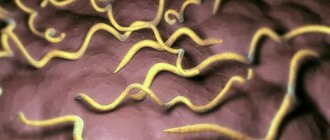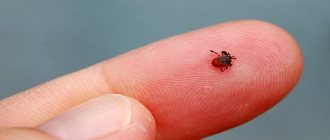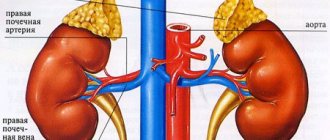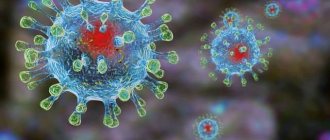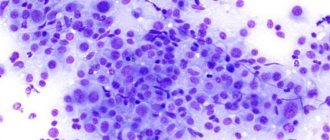Leptospirosis (Weill's disease, infectious jaundice)
– a dangerous contagious, zooanthroponotic disease of an infectious nature, which is characterized by hemorrhagic damage to the liver, blood vessels, kidneys, and other body systems. Leptospirosis is manifested by a sudden increase in temperature, diarrhea, disturbances in the gastrointestinal tract, and anemia. Disturbances in the functioning of the central nervous system are often noted. It is dangerous for humans, all types of mammals (dogs, cats, farm animals), wild carnivores, various types of rodents, and birds.
All breeds of dogs are susceptible to the disease, regardless of age. Leptospirosis is especially dangerous for young dogs, puppies due to incompletely developed immunity, as well as breeds with a loose constitution (boxer, French, English bulldog, cane corso, bullmastiff, sharpei, bloodhound, basset hound). Leptospirosis is very difficult to treat and in most cases, if appropriate measures are not taken, it ends in death. A favorable prognosis is possible only in the case of timely diagnosis and correctly selected treatment methods.
Etiology of leptospirosis
Leptospirosis in dogs is caused by pathogenic bacteria from the genus Leptospira. The bacterium has six different serotypes. In veterinary practice, in most cases, L. Icterohaemorrhagiae and L. Canicolau are isolated from dogs. In the external environment, Leptospires are active for up to 220 days in lakes, rivers, and polluted reservoirs. The lifespan of the bacterium in moist soil can range from 79 to 280 days. Shows resistance to disinfectants, with the exception of disinfectants of the first group.
Carriers of pathogenic bacteria and the source of release of Leptospira into the external environment are recovered, infected animals. Infected individuals shed bacteria in their stool, milk, secretions from the genitals, and lungs. The main lifelong reservoir and virus carriers are small rodents (mice, rats, voles). Outbreaks of leptospirosis are most often diagnosed in the autumn-summer period.
What kind of disease is this?
The causative agent of this infectious disease is a bacterium from the spirochete family. It causes leptospirosis in both dogs and humans.
Such bacteria are resistant to aggressive external environments. Most often they live and breed in water. An animal can become infected through another infected carrier. Bacteria can be excreted in body fluids, semen and urine. In rare cases, a dog may become ill after being bitten by a tick or other blood-sucking insect.
Initially, the bacteria penetrate the animal’s liver, where they actively multiply. Further, they spread throughout the bloodstream, releasing toxins.
With this disease, the main blow falls on the liver and circulatory system. Due to the fact that bacteria activate the production of hemoglobin, depletion of coagulation systems occurs. All these processes lead to bleeding and necrosis.
The disease can be carried by both domestic and wild animals. A dog that has had leptospirosis can release dangerous bacteria into the external environment for 2 years. Rodents are lifelong carriers of harmful bacteria.
To prevent infection of other animals and people, the sick dog must be completely isolated during treatment.
How dogs become infected with leptospirosis
Infection of healthy dogs with leptospirosis occurs through typical contact with infected individuals, through shared equipment, household items (bowls, collars, brushes), when eating low-quality food contaminated with leptospira, through water. Infection with leptospirosis can occur when dogs bathe in infected, contaminated bodies of water with stagnant water, especially during the hot season. It is possible that a dog is infected with leptospirosis through a transmissible route, through the bites of dangerous ectoparasites (fleas, ticks).
At risk are dogs with weakened immune systems and animals kept in unfavorable conditions in group or shared housing.
Bacteria enter the body through the mucous membranes, organs of the respiratory system, the genitourinary tract when mating with bacteria-carrying dogs, and damaged skin.
In the process of infection with leptospirosis, two stages are noted: bacteremic, in which active proliferation of bacteria occurs in the bloodstream, and toxic. After the penetration of pathogenic bacteria into the body, leptospira quickly spreads through the bloodstream to the parenchymal organs - kidneys, lungs, liver, where they localize, intensively divide, and reproduce.
The duration of the incubation period ranges from two to three to thirteen days, after which the Leptospira bacteria again penetrate into the bloodstream, releasing poisons and exotoxins that destroy the endothelium of the capillaries. Intoxication of the body occurs, vascular permeability increases, and homeostatic processes are disrupted. Poisons and toxins of Leptospira provoke convulsions and pathological disorders in the functioning of the central nervous system.
After about 5-8 days, a dog infected with leptospirosis begins to release leptospira into the external environment. The duration depends on the type of Leptospira, the general condition, the body’s resistance, the form (stage) of the disease, and the virulence of the viruses. Leptospira virus shedding can last from several days/weeks to several years
About leptospirosis and ways of contracting the disease
Leptospirosis in dogs, also known as Weil's disease or infectious jaundice, is caused by tiny Leptospira bacteria.
Particularly at risk are puppies, young and weakened dogs, hunting animals, and yard dogs. The disease can be “spread” from one dog to another (through saliva, during mating); often the carriers are rodents and farm animals - intermediate hosts of Leptospira. It should be noted that leptospirosis is often transmitted to a healthy animal from a dog that has recovered from the disease, which sometimes remains a microbial carrier for up to 3-4 years. A healthy dog only needs to, say, communicate with a fellow dog who has recently been ill, eat bread bitten by a mouse, drink contaminated milk from a sick cow, or swim in a pond from which infected horses drank, and Leptospira will end up in his body. Bacteria are most aggressive in the warm and hot seasons, while in winter their activity is reduced, but not reduced to zero.
The first symptoms of a bacterial infection can appear as early as a day after infection, but sometimes the disease remains undetected for 3 weeks, and all this time the dog owners will remain blissfully unaware, because almost no symptoms of infection will be visible. Perhaps, except for a slight decrease in appetite and moderate lethargy, all other symptoms of leptospirosis in dogs will soon manifest themselves.
Leptospirosis in pets can take the following course:
- Subacute
- the dog looks healthy for 15-20 days after the invasion of the pathogen, after which the first signs of the disease appear, which are not too pronounced; - Acute
is the most dangerous form of the disease; it is believed that no more than 25% of dogs have a chance of survival. The first symptoms appear within a day or three after infection; - Chronic
– when the disease accompanies the dog for years, periodically either without showing any symptoms or showing signs of bacterial activity.
Symptoms of leptospirosis infection in dogs
Leptospirosis in dogs can occur in several forms:
- acute;
- subacute;
- chronic;
- asymptomatic (latent).
The severity and form of leptospirosis are determined by the severity of the hemorrhagic symptom, as well as how severely the liver is affected (jaundice). Taking these factors into account, leptospirosis in dogs in veterinary practice is classified into:
- hemorrhagic (anicteric);
- icteric.
The icteric form of leptospirosis most often manifests itself when animals are infected with L.icterohaemorrhagiae, the hemorrhagic form - with L.pomona.
Diagnostics
The history and symptoms allow us to make a fairly confident diagnosis. But laboratory research plays a dominant role. The most commonly used method is serological analysis. With the help of this study, all types of pathogenic Leptospira are recognized.
In addition to traditional methods, modern analysis for leptospirosis in dogs includes 2 tests:
- fluorescent antibody and antigen testing,
- polymerase chain reaction (amplification of DNA molecules).
These methods can examine the urine of a sick animal and tissue samples. When taking samples and conducting tests, one must take into account the fact that several days pass from the onset of the disease until the appearance of leptospira in the urine. A more reliable source of information can be considered tissue samples obtained by biopsy.
Polymerase chain reaction is a new method of propagation (amplification) of DNA molecules, which makes it possible to confidently identify the causative agent of the disease. The sensitivity of the test can lead to false positives if the samples taken for analysis are contaminated. The method is quite new and is not always included in the diagnostic arsenal of veterinary clinics.
Hemorrhagic form of leptospirosis in dogs
The hemorrhagic (anicteric) form of leptospirosis is in most cases diagnosed in adult and older dogs. Most often it occurs in an acute, subacute form. In the acute stage, the development of clinical symptoms occurs from two to five to six days. Animal mortality can reach 55-65%.
In the subacute stage of leptospirosis, clinical manifestations develop more slowly and are less pronounced. The duration of the disease ranges from 10 to 22-23 days, if leptospirosis is complicated by secondary diseases and infections. Mortality is 35-55%.
In some animals, the subacute, acute stage of leptospirosis passes into the chronic stage, with a mild clinical picture. Body temperature may be slightly elevated or within normal limits. Diagnose malfunctions in the gastrointestinal tract and central nervous system. A decline in protective forces and mechanisms is noted. In the chronic form, leptospirosis can occur in waves, in a relapsing form with varying intensity and severity of the clinical picture.
The first symptoms of leptospirosis can be noticed in a dog within a day from the moment of infection. The onset of the disease is indicated by short-term hyperthermia - a sharp increase in temperature to 41.0-41.5 degrees. Strong thirst, anemic mucous membranes and conjunctiva are noted. The dog reacts poorly to external stimuli, becomes lethargic, apathetic, and refuses food.
On the second day, the temperature drops to 37.5-38 degrees, and a characteristic, pronounced hemorrhagic syndrome develops due to blockage of blood vessels by Leptospira exotoxins and lysis of red blood cells. External and internal bleeding appears. The mucous membranes bleed heavily and necrotic foci appear.
Bleeding affects the gastrointestinal tract, other organs, and body systems. The dog has severe profuse diarrhea, dissemitive syndrome, bruising in the area of intramuscular injections, subcutaneous injections, attacks of nausea, and debilitating vomiting with blood. Mucus and blood clots are noticeable in stool and urine. Diarrhea may alternate with constipation. There is always an increased protein content in the urine. The animals are sedentary, apathetic, and completely refuse food. With hemorrhagic lesions of the meninges in dogs, severe nervous disorders and disturbances in the functioning of the central nervous system are noted.
When palpating the abdomen, in the area of the kidneys, and liver, dogs experience severe pain. This form of leptospirosis is accompanied by dehydration, intoxication, the acute stage of hemorrhagic enteritis, acute renal and liver failure, and oliguria. Clonic seizures have been reported in dogs.
Kinds
There are many types of this disease. Each of them has its own distinctive symptoms. The most common forms include the following:
- icteric;
- hemorrhagic;
- acute;
- chronic;
- subacute;
- atypical.
Icteric
In the icteric type of the disease, the liver is most affected. It is most often seen in puppies or young dogs. Leptospirosis may be asymptomatic until obvious signs of jaundice appear. After this, the following symptoms are observed:
- weakness;
- constipation and diarrhea;
- staining the mucous membranes yellow;
- change in urine color.
The mortality rate for this type of lesion varies from 50 to 60%. The further prognosis is unfavorable.
Hemorrhagic
In the hemorrhagic type, the kidneys are affected. This type of disease is often diagnosed in older dogs. The following symptoms are present:
- apathy;
- high body temperature at the onset of the disease;
- redness of the mucous membranes;
- formation of ulcers;
- external bleeding;
- pain in the abdominal area;
- frequent and sudden urge to urinate;
- general exhaustion.
Sometimes the icteric and hemorrhagic forms can merge. In this case, the animal develops yellowness of the mucous membranes and external bleeding.
Spicy
The acute form can appear 2 hours after infection. The animal refuses to eat and its temperature rises sharply. After a few more hours, vomiting and diarrhea with blood are observed. The dog feels very thirsty.
If she is not taken to the doctor in time, the animal will stop moving altogether. Lethal outcome is observed in almost 100% of cases. In this case, it may fall into a coma or suffer from severe convulsions. The acute form can last from 1 to 4 days.
Subacute
The subacute variety progresses more slowly. With timely treatment, the prognosis is favorable. The fatality rate is 30%. Observed for 6-10 days.
Chronic
The chronic form occurs when the animal has already suffered several diseases, but pathogenic bacteria still remain in the body.
Symptoms include bowel movements and vomiting. An animal with a chronic form of leptospirosis becomes inactive and quickly loses weight. If the dog is pregnant, there is a high risk of stillbirth. This painful condition can last from several months to 2 years.
Atypical
The peculiarity of the atypical form is its asymptomatic course. The presence of bacteria in the body can only be detected through a urine test. This form is characterized by damage to the heart muscle and vascular system.
Jaundice form of leptospirosis
The most characteristic clinical manifestations of the icteric form of leptospirosis include: yellowness of the mucous membranes of the nasal cavity, oral cavity, genital organs, conjunctiva, skin, inner surface of the ears, depression, refusal to eat, dyspeptic syndrome - diarrhea, vomiting, anorexia. An increased concentration of bilirubin is noted in the blood. Similarly with the hemorrhagic form, kidney and liver failure, disturbances in the gastrointestinal tract, liver dysfunction, and pain on palpation of the peritoneum are diagnosed. Severe gastrointestinal lesions cannot be ruled out. The cause of death in dogs can be toxic-infectious shock, severe intoxication, and dehydration. After recovery, dogs can be diagnosed with keratitis and conjunctivitis.
Forms and course of the disease
Veterinary specialists note 4 forms of the disease:
- Spicy . Signs of the disease appear 1-3 days after the pathogen enters the body.
- I'll sharpen it up. Obvious symptoms of leptospirosis appear 10-20 days from the onset of the disease.
- Chronic . The infection lasts from 2 months to several years and is practically not accompanied by clear signs.
- Latent . Any manifestation of the disease is completely absent, but the ability to infect other animals remains for several years.
In the acute course of leptospirosis, the death of dogs occurs in 85% of cases ; the subacute course takes the lives of 60% of animals.
Hemorrhagic and icteric forms of leptospirosis are also distinguished.
The hemorrhagic form of the disease mainly affects adult canines, in which the disease is characterized by an acute and subacute course; dogs of any age are susceptible to jaundice.
The hemorrhagic form of leptospirosis has a higher mortality rate among sick dogs, but the icteric form is less tolerated by animals.
Veterinarians note that if an infected dog survives the first 5 days of the disease, it has a chance of a full recovery.
Diagnosis of leptospirosis in dogs
To establish leptospirosis, a complete, comprehensive examination of animals is carried out, and epizootological data for the region is studied. The diagnosis is made on the basis of anamnesis and obvious clinical manifestations. If leptospirosis is suspected, animals are prescribed laboratory tests, biochemical, and serological tests. Since leptospirosis has similar symptoms to other infectious viral diseases (canine distemper, infectious hepatitis), differential diagnosis is mandatory.
Treatment rules
As soon as there is a suspicion of leptospirosis, the owner must immediately contact a veterinarian and carry out the necessary diagnostics. If leptospires are found in the urine, viable even 2 hours after the test is taken, the doctor will report this. To fully confirm the diagnosis, the pet must be isolated from other patients for further testing and treatment.
Pets can get your help, but it will be completely ineffective against leptospirosis. It’s worth saying even more: a dog is an active source of infection, including for its own owner. Throughout the course of treatment, the dog must be kept separately and cared for while observing all precautions. To treat a dog, veterinarians use therapy techniques.
The treatment option is quite effective at first, due to the fact that it is aimed at reducing or completely destroying the number of spirochetes. The best option is hyperimmune serum. Streptomycin destroys the bacteria living inside.
If symptomatic treatment is carried out, the toxic load can be significantly reduced. An excellent remedy would be intravenous infusions, which include rehydrating agents, anticonvulsants, and antispasmodics. In the case of hemorrhagic form, hemostatic drugs are taken.
In the case of the most acute phase, when the animal completely refuses food, you should not force feed it. During the recovery process, the pet is prescribed dietary food that does not burden the affected organs. The icteric form of the disease forces you to feed the dog in small portions, preferably with medicinal food already prepared for this purpose. A special type of food for the hemorrhagic form can be purchased at veterinary hospitals. All manipulations are aimed at treating leptospirosis in dogs:
- elimination of the pathogen;
- destruction of intoxication;
- restoration of kidney and liver function, as well as heart and blood vessels;
- stopping vomiting and diarrhea.
Medicines are administered intravenously. Due to exhaustion of the body, weakness of the heart and blood vessels, the procedure is performed subcutaneously, since they are not absorbed intramuscularly. Thus, the drugs are not able to have any effect.
There are two ways to cope with the destruction of the pathogen. The fight against leptospira in the blood occurs on the basis of serum with antibodies. In addition to binding, serums can stimulate the immune system. The destruction of pathogens in organs occurs on the basis of antibiotics, the choice of which depends on the condition of the animal.
You can get rid of intoxication by administering nutrient solutions intravenously. The binding of toxins occurs on the basis of sodium thiosulfate and similar drugs. The choice is based on the stage of the disease and the immediate condition of the pet. In the early stages of the disease, while maintaining production, a 40% glucose solution is administered to remove toxins or 25% magnesium sulfate.
To restore the functioning of the liver and kidneys, you should immediately begin to destroy the pathogen. Kidney restoration is carried out on the basis of lespenefril or similar drugs. Liver restoration occurs through the introduction of enzymes (essentiale). As soon as the diarrhea and vomiting are stopped, Karsil is prescribed for several months in advance.
Homeopathic medicines are also used. Sometimes it is possible to combine traditional medications with homeopathic ones, which greatly enhances the effect. Most cases require stopping the diarrhea and vomiting.
Cerucal can cope with bouts of vomiting, but you should take the medicine with caution due to the difficulty of predicting its effect on the intestines. You can stop diarrhea with enterosgel and similar remedies. We must not forget that leptospirosis will forever negatively affect the health of the pet. When your pet has lost activity, is tracking and is breathing heavily, has diarrhea and vomiting, it is time to contact a veterinarian.
Treatment of leptospirosis in dogs
Treatment of leptospirosis is carried out only after an accurately established diagnosis. Treatment methods should only be prescribed by a veterinary medicine specialist, based on the results of diagnostic data. At the first, even minor clinical manifestations, deterioration in the general condition of your beloved pet, you should immediately take the dog to a veterinary clinic for diagnostics. Under no circumstances should you delay visiting a veterinary clinic, much less self-medicate. Remember, every day, every hour can cost the life of your beloved four-legged friend.
For leptospirosis, the veterinarian prescribes complex therapeutic etiotropic, pathogenetic, and symptomatic therapy. For etiotropic therapy, especially in the early stages of infection, good results are achieved by the use of hyperimmune serums, which are administered over two to three days.
Treatment of leptospirosis is aimed at:
- eliminating bacteria in the body;
- normalization and restoration of the functioning of affected organs and systems;
- removing signs of intoxication;
- normalization of digestive processes;
- increasing protective immune mechanisms.
To treat leptospirosis, dogs are prescribed antibiotic therapy. Medicines of the penicillin, chloramphenicol, tetracycline, streptomycin series (benzylpenicillin) are used to achieve an increased concentration of bicillin in the bloodstream. The dosage and duration of the course are prescribed individually, depending on the form, condition of the body, and age of the animals.
Sulfonamides are not recommended for use in the treatment of leptospirosis. Most medications are administered intravenously to infected dogs due to disruption and depletion of the vascular system.
To maintain immunity, dogs are prescribed immunomodulators and vitamin and mineral preparations. To eliminate the symptoms of dehydration and intoxication, dogs are prescribed rehydration using saline, physico-water, nutrient solutions, detoxification, and hemodesis.
To normalize the functioning of the gastrointestinal tract, animals are prescribed a specially developed therapeutic diet and vitamin preparations of group B. To restore liver function, hepatoprotectors (Essentiale, Galstena, Karsil) are prescribed. To restore blood vessels, animals are prescribed ascorbic acid and rutin. To strengthen the heart muscle - thiotriazoline, riboxin, and other pacemakers. Complex treatment and antibiotic therapy are often complemented by homeopathy.
The prognosis for leptospirosis if you visit a veterinary clinic in a timely manner is favorable. In acute, subacute hemorrhagic, the outcome is unfavorable and may result in death.
Dogs that have recovered from leptospirosis develop lifelong sterile, non-sterile immunity. After treatment, if the prognosis is favorable, owners should closely monitor the health of their pet.
Symptoms and signs in dogs
The disease has a huge number of clinical signs, as it affects almost all internal organs, nervous and circulatory systems, and skeletal muscles . American doctors have nicknamed leptospirosis the chameleon disease, because due to the number of symptoms, leptospirosis can be confused with canine distemper or infectious hepatitis.
Main symptoms and signs of leptospirosis:
- Apathetic state, inactivity;
- Refusal to eat;
- Redness or yellowing of mucous membranes;
- Vomit;
- Diarrhea, other signs of gastrointestinal disorders;
- Blood in the urine, dark urine;
- Poor urination, decreased amount of urine;
- Stomatitis;
- Increased body temperature;
- Deterioration of blood clotting;
- Lameness, loss of coordination;
- Shortness of breath, rapid pulse;
- Wheezing when breathing;
- Yellowness of the epithelium and mucous membranes;
- Dehydration;
- Abdominal pain;
- Anorexia.
Most often, symptoms appear 4–9 days after infection. Signs of leptospirosis may vary depending on which organs are affected. All organs may be affected, in which case the symptoms will be extensive. But the greatest danger this disease poses is that the symptoms are not always pronounced; it all depends on the individual characteristics of the body.
After entering the body, the easiest way for Leptospira bacteria to penetrate is the kidneys; therefore, the first clinical signs are associated with urination. Then the functioning of the liver, gastrointestinal tract, and spleen is disrupted. Also, the walls of blood vessels are destroyed, the functioning of the circulatory system is disrupted, which leads to internal bleeding.
Important! Animals that have recovered from the disease remain carriers of Leptospira for a long time.
Prevention of leptospirosis in dogs
Leptospirosis is a very dangerous infectious disease for dogs, regardless of breed or age. To prevent infection with leptospirosis, preventive vaccination is carried out. Mono- and polyvaccines are used, as well as associated vaccines of domestic and foreign production, which should be effective against Leptospira serotypes Icterohaemorrhagiae, Canicola (Biovac-L, Leptodog, Multikan-6). The dosage of the administered drug is indicated on the packaging and depends on the dog’s body weight. Puppies are vaccinated against leptospirosis for the first time at the age of 8-9 weeks. Repeated vaccination is carried out after three weeks.
For adult dogs and animals with unknown immune status or unfavorable epizootic conditions in the region, active-passive vaccination and hyperimmune serums are used. If you plan to travel with your dog to a region unfavorable for leptospirosis, preventive vaccination is carried out a month before the planned trip. Dog breeders should pay attention to the living conditions and diet of their four-legged friends. Do not neglect hygienic and preventive methods, pay attention to strengthening the body’s immune forces, adhere to the established vaccination schedule, and promptly treat your pet against ectoparasites. Always ensure the cleanliness of the enclosure and the dog’s sleeping place.

